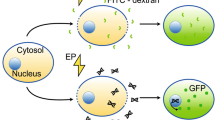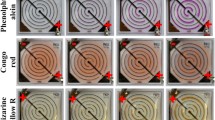Abstract
Electrotransfection has been widely used as a versatile, non-viral method for gene delivery. However, electrotransfection efficiency (eTE) is still low and unstable, compared to viral methods. To understand potential mechanisms of the problems, we investigated effects of electrode materials on eTE and viability of mammalian cells. Data from the study showed that commonly used metal electrodes generated a significant amount of particles during application of pulsed electric field, which could cause precipitation of plasmid DNA from solutions, thereby reducing eTE. For aluminum electrodes, the particles were composed of aluminum hydroxide and/or aluminum oxide, and their median sizes were 300–400 nm after the buffer was pulsed 4–8 times at 400 V cm−1, 5 ms duration and 1 Hz frequency. The precipitation could be prevented by using carbon (graphite) electrodes in electrotransfection experiments. The use of carbon electrodes also increased cell viability. Taken together, the study suggested that electrodes made of electrochemically inert materials were desirable for electrotransfection of cells in vitro.





Similar content being viewed by others
References
Ayuni, E. L., A. Gazdhar, M. N. Giraud, A. Kadner, M. Gugger, M. Cecchini, T. Caus, T. P. Carrel, R. A. Schmid, and H. T. Tevaearai. In vivo electroporation mediated gene delivery to the beating heart. PLoS One 5:e14467, 2010.
Bodles-Brakhop, A. M., R. Heller, and R. Draghia-Akli. Electroporation for the delivery of DNA-based vaccines and immunotherapeutics: current clinical developments. Mol. Therapy 17:585–592, 2009.
Chang, C.-C., M. Wu, and F. Yuan. Role of specific endocytic pathways in electrotransfection of cells. Mol. Therapy Methods Clin. Dev. 1:14058-8, 2014.
Eynard, N., M. P. Rols, V. Ganeva, B. Galutzov, N. Sabri, and J. Teissie. Electrotransformation pathways of procaryotic and eucaryotic cells: recent developments. Bioelectrochem. Bioenerg. 44:103–110, 1997.
Gothelf, A., and J. Gehl. Gene electrotransfer to skin; review of existing literature and clinical perspectives. Curr. Gene Ther. 10:287–299, 2010.
Hargrave, B., H. Downey, R. J. Strange, L. Murray, C. Cinnamond, C. Lundberg, A. Israel, Y.-J. Chen, W. J. Marshall, and R. Heller. Electroporation-mediated gene transfer directly to the swine heart. Gene Ther. 20:151–157, 2013.
Heller, L. C., and R. Heller. In vivo electroporation for gene therapy. Hum. Gene Ther. 17:890–897, 2006.
Heller, R., and L. C. Heller. Gene electrotransfer clinical trials. Adv. Genet. 89:235–262, 2015.
Heller, R., M. Jaroszeski, A. Atkin, D. Moradpour, R. Gilbert, J. Wands, and C. Nicolau. In vivo gene electroinjection and expression in rat liver. FEBS Lett. 389:225–228, 1996.
Henshaw, J., B. Mossop, and F. Yuan. Enhancement of electric field-mediated gene delivery through pretreatment of tumors with a hyperosmotic mannitol solution. Cancer Gene Ther. 18:26–33, 2010.
Jaichandran, S., S. T. B. Yap, A. B. M. Khoo, L. P. Ho, S. L. Tien, and O. L. Kon. In vivo liver electroporation: optimization and demonstration of therapeutic efficacy. Hum. Gene Ther. 17:362–375, 2006.
Kammerer, R., J. Barth, F. Gerken, C. Kunz, S. A. Flodstrom, and L. I. Johansson. Surface-binding-energy shifts for sodium, magnesium, and aluminum metals. Phys. Rev. B 26:3491–3494, 1982.
Kooijmans, S. A. A., S. Stremersch, K. Braeckmans, S. C. De Smedt, A. Hendrix, M. J. A. Wood, R. M. Schiffelers, K. Raemdonck, and P. Vader. Electroporation-induced siRNA precipitation obscures the efficiency of siRNA loading into extracellular vesicles. J. Control. Release 172:229–238, 2013.
Lepik, D., V. Jaks, L. Kadaja, S. Varv, and T. Maimets. Electroporation and carrier DNA cause p53 activation, cell cycle arrest, and apoptosis. Anal. Biochem. 318:52–59, 2003.
Loomis-Husselbee, J. W., P. J. Cullen, R. F. Irvine, and A. P. Dawson. Electroporation can cause artefacts due to solubilization of cations from the electrode plates. Aluminum ions enhance conversion of inositol 1,3,4,5-tetrakisphosphate into inositol 1,4,5-trisphosphate in electroporated L1210 cells. Biochem. J. 277(3):883–885, 1991.
Meaking, W. S., J. Edgerton, C. W. Wharton, and R. A. Meldrum. Electroporation-induced damage in mammalian cell DNA. Biochim. Biophys. Acta 1264:357–362, 1995.
Mir, L. M., M. F. Bureau, J. Gehl, R. Rangara, D. Rouy, J. M. Caillaud, P. Delaere, D. Branellec, B. Schwartz, and D. Scherman. High-efficiency gene transfer into skeletal muscle mediated by electric pulses. Proc. Natl. Acad. Sci. 96:4262–4267, 1999.
Neumann, E., M. Schaefer-Ridder, Y. Wang, and P. H. Hofschneider. Gene transfer into mouse lyoma cells by electroporation in high electric fields. EMBO J. 1:841–845, 1982.
Nishi, T., K. Yoshizato, S. Yamashiro, H. Takeshima, K. Sato, K. Hamada, I. Kitamura, T. Yoshimura, H. Saya, J. Kuratsu, and Y. Ushio. High-efficiency in vivo gene transfer using intraarterial plasmid DNA injection following in vivo electroporation. Cancer Res. 56:1050–1055, 1996.
Potter, H., L. Weir, and P. Leder. Enhancer-dependent expression of human kappa immunoglobulin genes introduced into mouse pre-B lymphocytes by electroporation. Proc. Natl. Acad. Sci. 81:7161–7165, 1984.
Rhaese, S., H. von Briesen, H. Rubsamen-Waigmann, J. Kreuter, and K. Langer. Human serum albumin-polyethylenimine nanoparticles for gene delivery. J. Control. Release 92:199–208, 2003.
Rosazza, C., E. Phez, J. M. Escoffre, L. Cezanne, A. Zumbusch, and M. P. Rols. Cholesterol implications in plasmid DNA electrotransfer: Evidence for the involvement of endocytotic pathways. Int. J. Pharm. 423:134–143, 2012.
Saulis, G., R. Lapė, R. Pranevičiūtė, and D. Mickevičius. Changes of the solution pH due to exposure by high-voltage electric pulses. Bioelectrochemistry 67:101–108, 2005.
Stapulionis, R. Electric pulse-induced precipitation of biological macromolecules in electroporation. Bioelectrochem. Bioenerg. 48:1–6, 1999.
Tamiya, E., Y. Nakajima, H. Kamioka, M. Suzuki, and I. Karube. DNA cleavage based on high voltage electric pulse. FEBS Lett. 234:357–361, 1988.
Touchard, E., M. Berdugo, P. Bigey, M. El Sanharawi, M. Savoldelli, M.-C. Naud, J.-C. Jeanny, and F. Behar-Cohen. Suprachoroidal electrotransfer: a nonviral gene delivery method to transfect the choroid and the retina without detaching the retina. Mol. Therapy 20:1559–1570, 2012.
Venslauskas, M. S., and S. Šatkauskas. Mechanisms of transfer of bioactive molecules through the cell membrane by electroporation. Eur. Biophys. J. 44:1–13, 2015.
Wolff, J. A., and V. Budker. The mechanism of naked DNA uptake and expression. Adv. Genet. 54:1–20, 2015.
Wu, M., and F. Yuan. Membrane binding of plasmid DNA and endocytic pathways are involved in electrotransfection of mammalian cells. PLoS One 6:e20923, 2011.
Xu, Z. P., T. L. Walker, K.-L. Liu, H. M. Cooper, G. Q. M. Lu, and P. F. Bartlett. Layered double hydroxide nanoparticles as cellular delivery vectors of supercoiled plasmid DNA. Int. J. Nanomed. 2:163–174, 2007.
Zhou, R., J. E. Norton, N. Zhang, and D. A. Dean. Electroporation-mediated transfer of plasmids to the lung results in reduced TLR9 signaling and inflammation. Gene Ther. 14:775–780, 2007.
Acknowledgments
The work was supported partly by grants from National Institutes of Health (GM098520) and National Science Foundation (BES-0828630).
Conflict of Interest
Chun-Chi Chang, Mao Mao, Yang Liu, Mina Wu, Tuan Vo-Dinh, and Fan Yuan declare that they have no conflict of interest.
Ethical Standards
No human or animal studies were carried out by the authors for this article.
Author information
Authors and Affiliations
Corresponding author
Additional information
Associate Editor Alyssa Panitch oversaw the review of this article.
Rights and permissions
About this article
Cite this article
Chang, CC., Mao, M., Liu, Y. et al. Improvement in Electrotransfection of Cells Using Carbon-Based Electrodes. Cel. Mol. Bioeng. 9, 538–545 (2016). https://doi.org/10.1007/s12195-016-0452-9
Received:
Accepted:
Published:
Issue Date:
DOI: https://doi.org/10.1007/s12195-016-0452-9




